Catasetums do not rank as a genus among our beauties; in fact, saving C. pileatum, commonly called C. Bungerothi, and C. barbatum, I think of none, at this moment, which are worthy of attraction on that ground. C. fimbriatum, indeed, would be lovely if it could be persuaded to show itself. I have seen one plant which condescended to open its spotted blooms, but only one. No orchids, however, give more material for study; on this account Catasetum was a favourite with Mr. Darwin. It is approved also by unlearned persons who find relief from the monotony of admiration as they stroll round in observing its acrobatic performances. The “column” bears two horns; if these be touched, the pollen-masses fly as if discharged from a catapult. C. pileatum, however, is very handsome, four inches across, ivory white, with a round well in the centre of its broad lip, which makes a theme for endless speculation. The daring eccentricities of colour in this class of plant have no stronger example than C. callosum, a novelty from Caraccas, with inky brown sepals and petals, brightest orange column, labellum of verdigris-green tipped with orange to match.
Schomburgkias are not often seen. Having a boundless choice of fine things which grow and flower without reluctance, the practical gardener gets irritated in these days when he finds a plant beyond his skill. It is a pity, for the Schomburgkias are glorious things—in especial Sch. tibicinis. No description has done it justice, and few are privileged to speak as eye-witnesses. The clustering flowers hang down, sepals and petals of dusky mauve, most gracefully frilled and twisted, encircling a great hollow labellum which ends in a golden drop. That part of the cavity which is visible between the handsome incurved wings has bold stripes of dark crimson. The species is interesting, too. It comes from Honduras, where the children use its great hollow pseudo-bulbs as trumpets—whence the name. At their base is a hole—a touch-hole, as we may say, the utility of which defies our botanists. Had Mr. Belt travelled in those parts, he might have discovered the secret, as in the similar case of the Bullthorn, one of the Gummiferae. The great thorns of that bush have just such a hole, and Mr. Belt proved by lengthy observations that it is designed, to speak roughly, for the ingress of an ant peculiar to that acacia, whose duty it is to defend the young shoots—vide Belt’s “Naturalist in Nicaragua,” page 218. Importers are too well aware that Schomburgkia tibicinis also is inhabited by an ant of singular ferocity, for it survives the voyage, and rushes forth to battle when the case is opened. We may suppose that it performs a like service.




